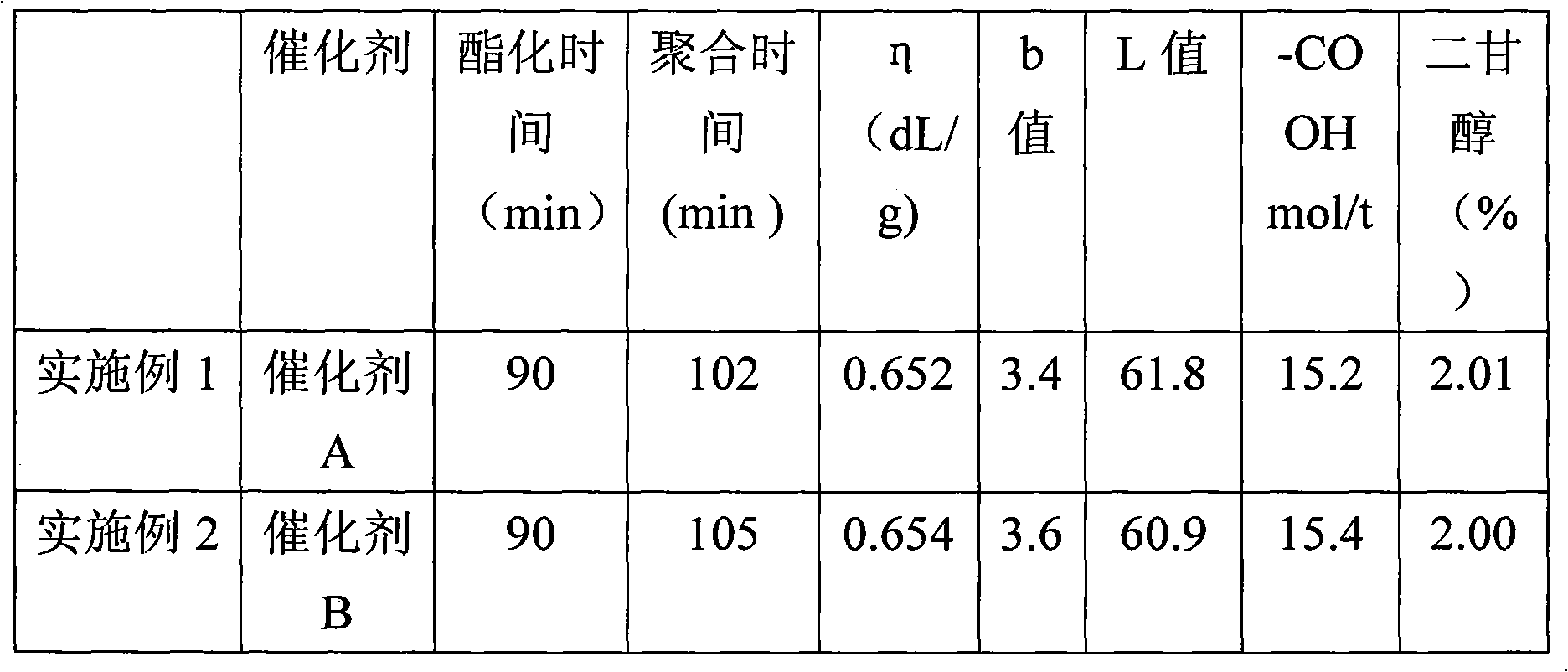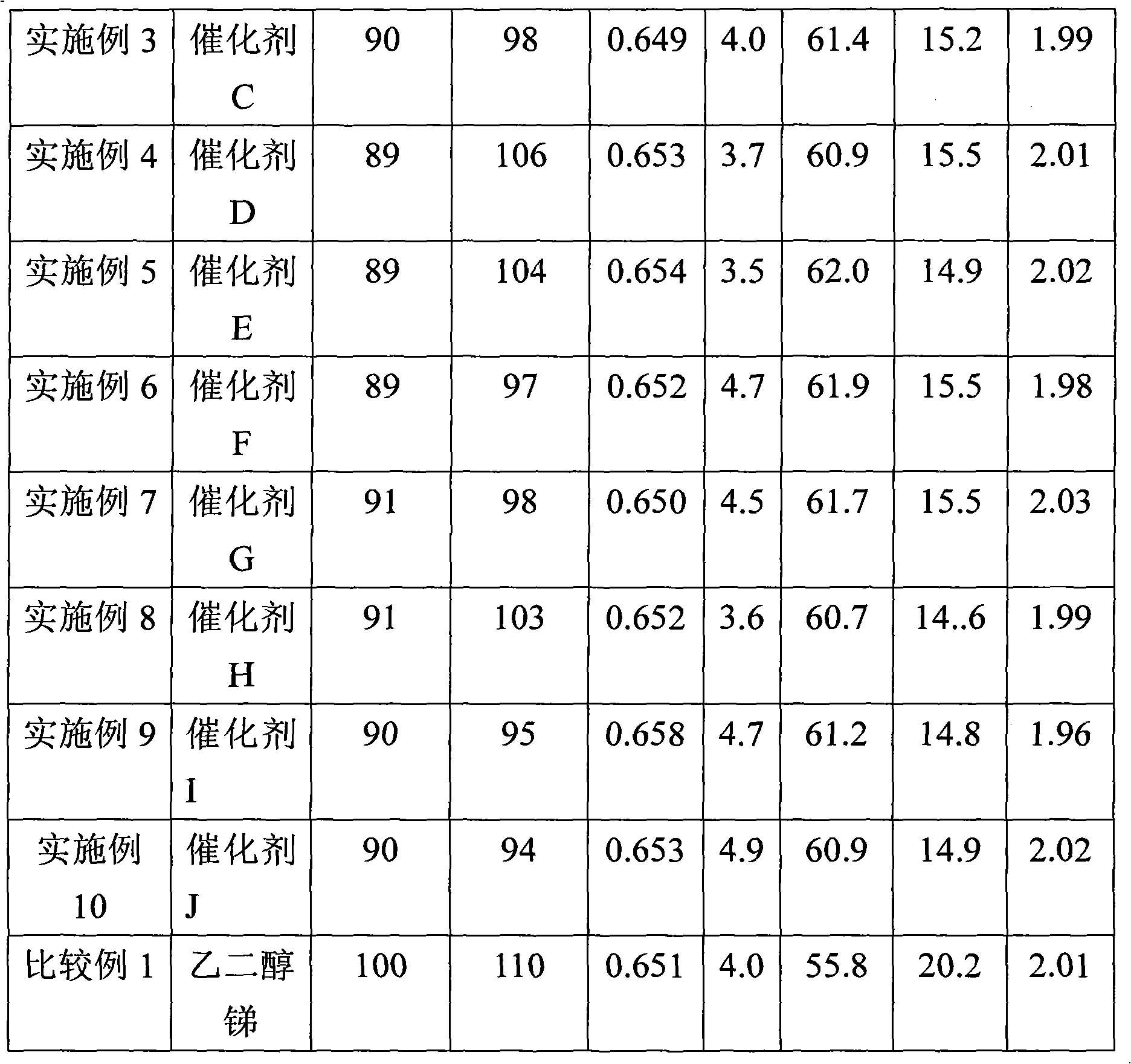Liquid titanium catalyst for polyester and copolyester and preparation method thereof
A technology of titanium-based catalyst and copolyester, which is applied in the field of catalyst and its preparation, can solve problems such as adverse effects, darkening of catalyst color, and affecting the color of polyester products, so as to achieve the effect of ensuring product quality and light color
- Summary
- Abstract
- Description
- Claims
- Application Information
AI Technical Summary
Problems solved by technology
Method used
Image
Examples
Embodiment 1
[0032]Add 42.6 g of tetraisopropyl titanate (0.15 mol), 3.1 g of tetraethyl orthosilicate (0.015 mol) and 100 g of absolute ethanol into a reactor equipped with a stirrer, a separatory funnel, and a condenser, and mix well. A mixed solution of 63.3 g of citric acid monohydrate (0.3 mol) and 150 g of absolute ethanol was slowly dropped into the reactor, and after the addition was completed, the mixture was reacted at room temperature to 100° C. for 1 hour. Precipitate a white precipitate, continue to add 4.1g sodium acetate (0.03mol) and 55.2g triethyl phosphate (0.3mol), react at 50-200°C for 0.5-3 hours, remove small molecules, until the system becomes a homogeneous liquid , to obtain catalyst A.
[0033] Preparation of polyester
[0034] With 500g terephthalic acid (PTA), 270g ethylene glycol (EG) and catalyst A (based on the amount of the polyester that generates, the weight content of titanium atom is 10 * 10 -6 ), add 2L polymerization reactor. The esterification react...
Embodiment 2
[0037] Add 51.1 g of tetrabutyl titanate (0.15 mol), 3.1 g of tetraethyl orthosilicate (0.015 mol) and 100 g of absolute ethanol into a reactor equipped with a stirrer, a separatory funnel, and a condenser, and mix well. A mixed solution of 63.3 g of citric acid monohydrate (0.3 mol) and 150 g of absolute ethanol was slowly dropped into the reactor, and after the addition was completed, the mixture was reacted at room temperature to 100° C. for 1 hour. Precipitate a white precipitate, continue to add 6.4g magnesium acetate (0.03mol) and 82.8g triethyl phosphate (0.45mol), react at 50-200°C for 0.5-3 hours, remove small molecules, until the system becomes a homogeneous liquid , to obtain catalyst B.
[0038] Preparation of polyester
[0039] Adopt the same method as embodiment 1 to prepare polyester, use catalyst B as catalyst (based on the amount of the polyester that generates, the weight content of titanium atom is 10 * 10 -6 ).
[0040] The obtained PET product was subje...
Embodiment 3
[0042] Add 42.6 g of tetraisopropyl titanate (0.15 mol), 6.2 g of tetraethyl orthosilicate (0.03 mol) and 100 g of absolute ethanol into a reactor equipped with a stirrer, a separatory funnel and a condenser, and mix well. A mixed solution of 63.3 g of citric acid monohydrate (0.3 mol) and 150 g of absolute ethanol was slowly dropped into the reactor, and after the addition was completed, the mixture was reacted at room temperature to 100° C. for 1 hour. Precipitate a white precipitate, continue to add 6.6g zinc acetate (0.03mol) and 55.2g triethyl phosphate (0.3mol), react at 50-200°C for 0.5-3 hours, remove small molecules, until the system becomes a homogeneous liquid , to obtain catalyst C.
[0043] Preparation of polyester
[0044] Adopt the same method as embodiment 1 to prepare polyester, use catalyst C as catalyst (based on the amount of the polyester that generates, the weight content of titanium atom is 10 * 10 -6 ).
[0045] The obtained PET product was subjected...
PUM
 Login to View More
Login to View More Abstract
Description
Claims
Application Information
 Login to View More
Login to View More - R&D
- Intellectual Property
- Life Sciences
- Materials
- Tech Scout
- Unparalleled Data Quality
- Higher Quality Content
- 60% Fewer Hallucinations
Browse by: Latest US Patents, China's latest patents, Technical Efficacy Thesaurus, Application Domain, Technology Topic, Popular Technical Reports.
© 2025 PatSnap. All rights reserved.Legal|Privacy policy|Modern Slavery Act Transparency Statement|Sitemap|About US| Contact US: help@patsnap.com



